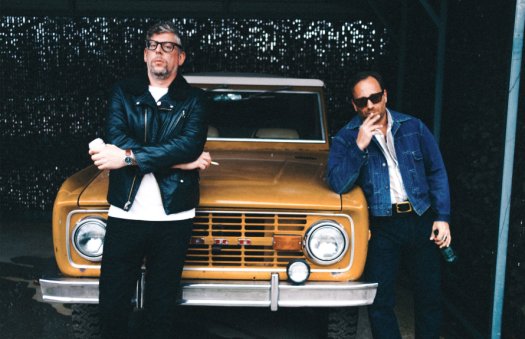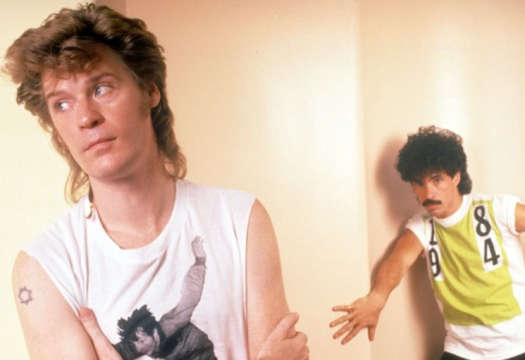Plenty of entertaining documentaries are built from being in the right place at the right time. The Painter and the Thief — a doc filled with twists, reversals, and a churn of events — got in on the action early. The first recorded conversation between the key pair in the film, Barbora Kysilkova and Karl-Bertil Norland, is be a fuzzy room mic recording accompanied by courtroom drawings. Even before that, though, director Benjamin Ree and filmmakers are talking with visual artist Kysilkova, who's had a pair of works stolen from a show and is interested in finding out more about one of the men involved.
Being around to capture the story as it unfolds from the beginning is one mark in The Painter and the Thief's favour. Another is how the filmmakers are approaching the material they've collected: with a cinematic eye and with some storytelling gusto.
One of the pieces stolen from Kysilkova's show is a cathartic piece marking her move from her life in Germany to her current situation in Norway. Early on, she gets a call from the police. They tell her the thieves have been caught but the pieces haven't been recovered and the case is closed.
She's not visibly upset by this. Instead, she's more curious about one of the thieves, Norland, a self-professed "Wednesday to Wednesday" partier with a "snitches are a dying breed" chest tattoo. Despite how they came to be acquainted, and following some early tentativeness and uneasiness, they open up to each other. His story builds out, the troubles he's gone through with crime and drugs, as well as his creative spirit. He sits for a portrait done by Kysilkova and, in the moment it's unveiled, he's overwhelmed in a touching way.
Ree and his crew were with the pair from the start of what brought them together, but they don't limit themselves to a linear approach. They're able to flash back to months to cover events from a different view, sometimes even replaying earlier scenes from the movie from a different angle, finding a new meaning specific to one of the two key subjects each time.
The doubling reaches to similarly structured stretches as well. Kysilkova, at one point, narrates Norland's life to date in brief, with his childhood photographs pictured. When he does the same for her, it's her art that's featured. There's also shots of each of them scanning the other's Facebook profile, but that's just our age.
The complex timeline and stylistic flourishes don't often detract from the story they're illuminating. In fact, the cinematic framing of the interviews supports whose perspective we're experiencing at any one time. They're living lives that intersect but don't overlap, and their understanding of each other is always limited by their own preoccupations at any one time. "Barbora keeps asking about my dark sides," Norland says in one moment, to note that he's more than just that.
The Painter and the Thief can also stand as an interesting document of their own personal progress. The lack of an A-to-B plot reflects the course of their lives; no one can expect to only mount successes without failures, pitfalls and setbacks. The movie is in love with its plentiful twists, of which there's no shortage. That said, the movie is best when it's playing into the personal development of the pair.
Hot Docs Film Festival has moved online for its 2020 edition. Buy tickets over at the festival's website.
Being around to capture the story as it unfolds from the beginning is one mark in The Painter and the Thief's favour. Another is how the filmmakers are approaching the material they've collected: with a cinematic eye and with some storytelling gusto.
One of the pieces stolen from Kysilkova's show is a cathartic piece marking her move from her life in Germany to her current situation in Norway. Early on, she gets a call from the police. They tell her the thieves have been caught but the pieces haven't been recovered and the case is closed.
She's not visibly upset by this. Instead, she's more curious about one of the thieves, Norland, a self-professed "Wednesday to Wednesday" partier with a "snitches are a dying breed" chest tattoo. Despite how they came to be acquainted, and following some early tentativeness and uneasiness, they open up to each other. His story builds out, the troubles he's gone through with crime and drugs, as well as his creative spirit. He sits for a portrait done by Kysilkova and, in the moment it's unveiled, he's overwhelmed in a touching way.
Ree and his crew were with the pair from the start of what brought them together, but they don't limit themselves to a linear approach. They're able to flash back to months to cover events from a different view, sometimes even replaying earlier scenes from the movie from a different angle, finding a new meaning specific to one of the two key subjects each time.
The doubling reaches to similarly structured stretches as well. Kysilkova, at one point, narrates Norland's life to date in brief, with his childhood photographs pictured. When he does the same for her, it's her art that's featured. There's also shots of each of them scanning the other's Facebook profile, but that's just our age.
The complex timeline and stylistic flourishes don't often detract from the story they're illuminating. In fact, the cinematic framing of the interviews supports whose perspective we're experiencing at any one time. They're living lives that intersect but don't overlap, and their understanding of each other is always limited by their own preoccupations at any one time. "Barbora keeps asking about my dark sides," Norland says in one moment, to note that he's more than just that.
The Painter and the Thief can also stand as an interesting document of their own personal progress. The lack of an A-to-B plot reflects the course of their lives; no one can expect to only mount successes without failures, pitfalls and setbacks. The movie is in love with its plentiful twists, of which there's no shortage. That said, the movie is best when it's playing into the personal development of the pair.
Hot Docs Film Festival has moved online for its 2020 edition. Buy tickets over at the festival's website.




